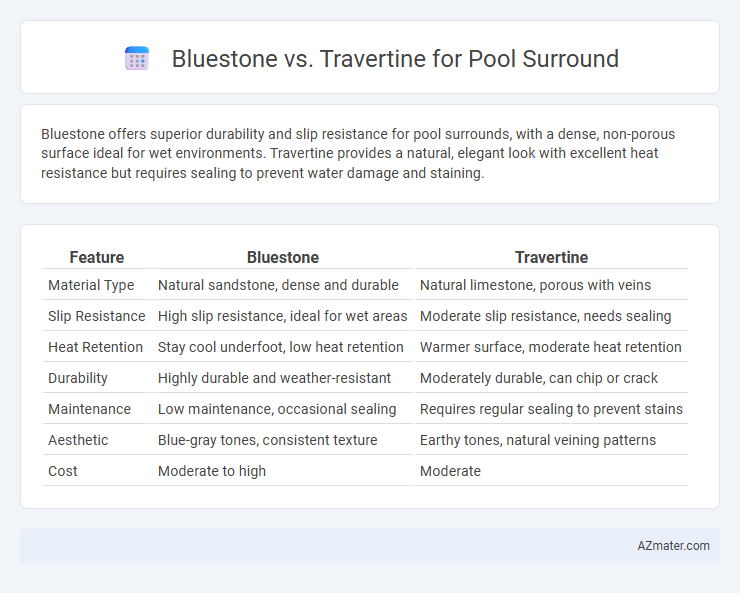Bluestone offers superior durability and slip resistance for pool surrounds, with a dense, non-porous surface ideal for wet environments. Travertine provides a natural, elegant look with excellent heat resistance but requires sealing to prevent water damage and staining.
Table of Comparison
| Feature | Bluestone | Travertine |
|---|---|---|
| Material Type | Natural sandstone, dense and durable | Natural limestone, porous with veins |
| Slip Resistance | High slip resistance, ideal for wet areas | Moderate slip resistance, needs sealing |
| Heat Retention | Stay cool underfoot, low heat retention | Warmer surface, moderate heat retention |
| Durability | Highly durable and weather-resistant | Moderately durable, can chip or crack |
| Maintenance | Low maintenance, occasional sealing | Requires regular sealing to prevent stains |
| Aesthetic | Blue-gray tones, consistent texture | Earthy tones, natural veining patterns |
| Cost | Moderate to high | Moderate |
Introduction to Bluestone and Travertine Pool Surrounds
Bluestone and travertine are popular natural stone choices for pool surrounds due to their durability and aesthetic appeal. Bluestone features a dense, fine-grained texture with rich blue-gray hues, offering excellent slip resistance and heat retention properties ideal for poolside areas. Travertine, characterized by its porous surface and warm earth tones, provides natural cooling effects and a luxurious, timeless look that enhances outdoor pool environments.
Aesthetic Appeal: Bluestone vs Travertine
Bluestone offers a sleek, modern aesthetic with its smooth texture and deep blue-gray tones, creating a sophisticated look for pool surrounds. Travertine provides a warm, natural appearance characterized by its porous texture and earthy beige hues, giving a classic Mediterranean vibe. Both materials enhance pool areas elegantly, but Bluestone suits contemporary designs, while Travertine complements traditional or rustic styles.
Durability and Longevity Comparison
Bluestone offers exceptional durability for pool surrounds due to its dense composition and resistance to chipping and weathering, making it ideal for high-traffic wet areas. Travertine, while aesthetically pleasing with natural pores, requires sealing to maintain longevity and prevent water damage or staining over time. When comparing longevity, Bluestone generally outperforms Travertine in retaining structural integrity and appearance under prolonged exposure to pool chemicals and extreme weather conditions.
Slip Resistance and Safety Factors
Bluestone and travertine are popular choices for pool surrounds due to their natural slip resistance and durability. Bluestone offers a textured surface that provides excellent traction even when wet, making it a safer option for high-traffic pool areas. Travertine, while visually appealing with its porous texture, requires sealing to enhance slip resistance and prevent water absorption, which can affect safety around pools.
Heat Retention and Comfort Underfoot
Bluestone exhibits superior heat retention compared to travertine, making it warmer underfoot during cooler evenings by absorbing and slowly releasing heat from the sun. Travertine remains cooler under direct sunlight, providing a comfortable, slip-resistant surface ideal for hot climates and bare feet. Both stones offer durability, but bluestone's thermal properties enhance comfort in varied temperatures, while travertine excels in maintaining a consistently cooler touch.
Maintenance Requirements for Both Stones
Bluestone requires regular sealing to prevent staining and minimize water absorption, making maintenance essential for preserving its durability around pools. Travertine is naturally porous, necessitating frequent cleaning and resealing to avoid damage from pool chemicals and moisture. Both stones benefit from routine inspections to address cracks or surface wear, ensuring long-term aesthetic appeal and safety.
Cost Analysis: Bluestone vs Travertine
Bluestone pool surrounds typically range from $15 to $30 per square foot, offering a durable and slip-resistant surface ideal for pool areas. Travertine costs vary between $20 and $35 per square foot, with its natural porous texture providing a cooler surface temperature underfoot. Considering installation and maintenance expenses, bluestone generally presents a more cost-effective option, while travertine's aesthetic appeal and cooling properties may justify its higher price in luxury settings.
Environmental Impact and Sustainability
Bluestone and travertine differ significantly in environmental impact and sustainability for pool surrounds. Bluestone, a dense igneous rock often quarried locally, tends to have a lower carbon footprint due to reduced transportation emissions and has high durability, minimizing replacement frequency. Travertine, a sedimentary limestone, involves energy-intensive extraction and processing but is a natural insulator with excellent heat resistance, contributing to energy savings around the pool area.
Installation Process and Considerations
Bluestone installation for pool surrounds requires skilled labor due to its dense, hard nature, often involving precise cutting and anchoring to prevent shifting; the stone's natural cleft finish offers excellent slip resistance but demands careful sealing to protect against pool chemicals. Travertine, being softer and more porous, is easier to cut and install yet needs thorough sealing to prevent water absorption and staining, with its smooth surface potentially requiring anti-slip treatments or textured finishes for safety. Both materials benefit from proper drainage design and substrate preparation to ensure longevity and minimize maintenance in poolside environments.
Which Stone is Best for Your Pool Surround?
Bluestone offers a dense, non-porous surface with exceptional slip resistance, making it highly durable and safe for pool surrounds in various climates. Travertine features a naturally textured surface that stays cool underfoot and provides excellent water drainage due to its porous composition, ideal for hot, sunny regions. Choosing between Bluestone and Travertine depends on your priority for temperature comfort versus long-term durability and slip resistance for poolside safety.

Infographic: Bluestone vs Travertine for Pool Surround
 azmater.com
azmater.com